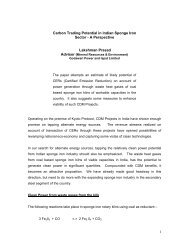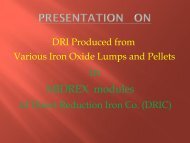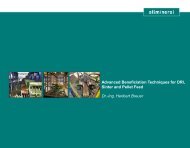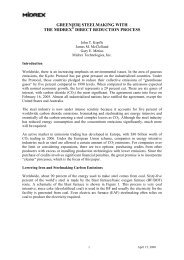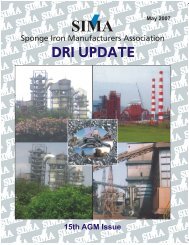December 2011 - SIMA
December 2011 - SIMA
December 2011 - SIMA
Create successful ePaper yourself
Turn your PDF publications into a flip-book with our unique Google optimized e-Paper software.
Target Setting:The methodology for target setting will be based onSEC reduction on gate-to-gate basis and will be suchas to achieve the targeted savings in the firstcommitment period of 3 years (<strong>2011</strong>-14).Theallocation of reduction of target would correspond tothe disaggregation of sectoral reduction target to eachplant within the sector.The target SEC is required to be achieved over a 3year period commencing from 1 st April <strong>2011</strong>. All theDCs would reduce their SEC, the less energy-efficientDCs in a sector being required to achieve a greaterreduction in their SEC than the more energy-efficientDCs in the same sector. The absolute energy savingat the end of three years would be estimated as..Energy saving=P (SEC – SEC )base year base yeartarget yearWhere P is the production quantity.Measurement & Verification(M&V) :As the baseline SEC is based on gate-to-gate basis,no measurement is involved for sub system or subprocesses of the plant. The M&V will be carried outby Designated Energy Auditors(DENA).There woundnot be any M & V during the intermediate years i.e.<strong>2011</strong> & 2014. However each DCs would be requiredto submit the annual energy consumption throughform-1 to BEE. In addition to this DCs are required toconduct one or two energy audits by accreditedenergy auditors, which will form a basis of M&V inthe target year.Energy Saving Certificates & Trading:If in the target year a DC achieves more than thetarget, energy saving certificates (ESCerts)equivalent to the excess energy savings would beissued to the DC. On the other hand, if the DC failsto achieve the target, compliance to the target maybe met by purchasing ESCerts from other DCsthrough a trading platform. If any shortfall still remains,penalty (in financial terms) would be levied as perthe provisions of the Energy Conservation Act 2001.Penalty for non compliance of SEC is Rs 10Lakhsplus the value of non- compliance measured in termsof the market price of tonnes of oil equivalent.The Energy saving certificates can be traded in twopower exchanges (IEX & PXIL).A central onlineintegrated system (IIS) i.e. PAT-Net connecting allthe DCs, SDAs(state designated agency), DENAs(Designated Energy Auditors), Trading exchanges,central Registry & BEE will be deployed for exchangeof online accurate information, maintaining itsconfidentiality, transparency & security. The fig belowshows tentative process flow for ESCerts- tradingmechanism.(Courtesy PAT consultant document)DECEMBER-<strong>2011</strong>/3



